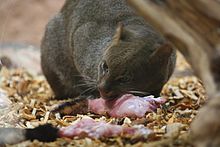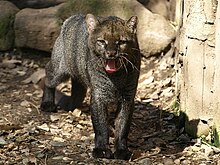Jaguarundi
| Jaguarundi | |
|---|---|

| |
| In the Pont-Scorff zoo | |
| Scientific classification | |
| Domain: | Eukaryota |
| Kingdom: | Animalia |
| Phylum: | Chordata |
| Class: | Mammalia |
| Order: | Carnivora |
| Suborder: | Feliformia |
| Family: | Felidae |
| Subfamily: | Felinae |
| Genus: | Herpailurus Severtzov, 1858 |
| Species: | H. yagouaroundi
|
| Binomial name | |
| Herpailurus yagouaroundi (Geoffroy Saint-Hilaire, 1803)
| |

| |
| Distribution of the jaguarundi (2015)[1] | |
| Synonyms[2] | |
The jaguarundi (Herpailurus yagouaroundi;
Secretive and alert, the jaguarundi is typically solitary or forms pairs in the wild, though captive individuals are more gregarious. Unlike other
The jaguarundi inhabits a broad array of both closed and open habitats ranging from
Etymology
The common name "jaguarundi" comes from the
Taxonomy
In 1803
- Felis eyra proposed by Gotthelf Fischer von Waldheim in 1814 was a ferruginous skin from Paraguay.[11]
- F. cacomitli proposed by Jean-Louis Berlandier in 1859 was a skull and a grayish skin of a female jaguarundi from the Rio Grande area in Mexico.[12]
- F. yagouaroundi tolteca proposed by Oldfield Thomas in 1898 was a skull and a reddish skin from Sinaloa in Mexico.[13]
- F. Ameghinoi proposed by excavated near San Luis, Argentina.[14]
- F. fossata by Edgar Alexander Mearns in 1901 was a large jaguarundi skull from Yucatán.[15]
- F. panamensis by Joel Asaph Allen in 1904 was a dusky gray skin of a young adult female jaguarundi collected in Panama's Chiriquí Province.[16]
- F. yagouaroundi melantho by Oldfield Thomas in 1914 were skulls and blackish brown skins of a male and a female from Pozuzo District in Peru.[17]
The
Phylogeny and evolution
| The Puma lineage of the family Felidae, depicted along with closely related genera[21] |
The jaguarundi is most closely related to the cougar; the jaguarundi-cougar clade is
The three species of the Puma lineage may have had a
The Puma lineage appears to have migrated from Asia to North America after crossing the
Characteristics
The jaguarundi is a medium-sized cat of slender build and uniform coloration that differs significantly from other
The coat is uniformly colored with at most a few faint markings on the face and the belly, though kittens are spotted for a short duration. Black and white marks on the lips and the snout, similar to those of the cougar, can be clearly seen in juveniles and some adults. Two color
Among felids, the jaguarundi is closely similar to the flat-headed cat (Prionailurus planiceps), but has a longer body and proportionately longer legs, is heavier and lacks the dark markings on the cheeks of the flat-headed cat.[10] Tawny jaguarundis bear a similar coloration to the larger cougar.[35]
The diploid number of chromosomes in jaguarundi is 2n=38.[40]
Distribution and habitat
The jaguarundi inhabits a wide variety of habitats, from tropical rainforests and
The range extends from central Argentina in the south to northern Mexico, through Central and South America east of the Andes — second only to the cougar in the
The occurrence of the jaguarundi in
Behavior and ecology

The jaguarundi is shy and reclusive, and apparently very cautious of
Studies have mostly observed jaguarundis alone or in pairs; pairs could probably be formed between mothers and older kittens or between individuals of opposite sexes during the mating season. Individuals in captivity have been found to be more gregarious.[34] Home ranges tend to be large; a study in Brazil recorded home ranges 1.4–18 km2 (0.54–6.95 sq mi) in size for females, while those of males measured 8.5–25.3 km2 (3.3–9.8 sq mi) in area.[35] Two males in Belize were recorded to have exceptionally large home ranges spanning an area of 88 km2 (34 sq mi) and 100 km2 (39 sq mi), while the home range of a female in the same region measured 13–20 km2 (5.0–7.7 sq mi) in size.[36] Population densities are typically low, around 0.01 to 0.05/km2 (0.026 to 0.129/sq mi) in Brazil, though Tamaulipas (Mexico) and the Llanos in Costa Rica and Venezuela have recorded figures as high as 0.2/km2 (0.52/sq mi).[30][48]
Marking behavior could serve as a means of olfactory or visual communication among jaguarundis; individuals in captivity have been observed scraping areas with their hind feet (sometimes with urination), clawing on logs,
Diet

The jaguarundi typically feed on small-sized prey weighing less than 1 kg (2.2 lb), including ground-feeding
Reproduction
Jaguarundis have been observed mating all year round, with peaks at different times of the year across the range; for instance, in Mexico breeding peaks in January and March. Estrus lasts three to five days, marked by the female regularly rolling onto her back and
After a
Threats and conservation

The jaguarundi has been listed as
Other threats include risks of
Hunting jaguarundi is restricted in Peru and banned in Argentina, Belize, Brazil, Bolivia, Colombia, Costa Rica, French Guiana, Guatemala, Honduras, Mexico, Panama, Paraguay, Suriname, Uruguay, United States, and Venezuela.[1]
References
- ^ . Retrieved 15 January 2022.
- ^ OCLC 62265494.
- ^ Ferreira, A.B.H. (1986). Novo Dicionário da Língua Portuguesa [New Dictionary of the Portuguese Language] (in Portuguese) (2nd ed.). Rio de Janeiro: Nova Fronteira. p. 980.
- ^ "jaguarundi". Merriam-Webster.com Dictionary. Retrieved 10 April 2020.
- ^ "jaguarundi". The American Heritage Dictionary of the English Language (5th ed.). HarperCollins.
- ^ "jaguarundi". Lexico UK English Dictionary. Oxford University Press. Archived from the original on October 17, 2021.
- ISBN 9788585371470.
- ISBN 978-2-8317-0045-8.
- ^ Geoffroy Saint-Hilaire, É. (1803). "Le chat yagouarundi. Felis yagouarundi (The cat jaguarundi: Felis yagouarundi)". Catalogue des Mammifères du Museum National d'Histoire Naturelle [Catalogue of Mammals of the National Museum of Natural History] (in French). Paris: Museum National d'Histoire Naturelle. p. 124.
- ^ JSTOR 3504500.
- ^ Fischer von Waldheim, G. (1814). "Felis eyra". Zoognosia tabulis synopticis illustrata : in usum praelectionum Academiae imperialis medico-chirugicae mosquensis edita (in Latin). Moscow: Nicolai S. Vsevolozsky. p. 228.
- ^ Berlandier, J.-L. (1859). "Felis yagouarundi (Desm.)". In Baird, S. F. (ed.). Report on the United States and Mexican boundary survey made under the direction of the Secretary of the Interior. Vol. II. Mammals of the boundary. Washington: A.O.P. Nicholson. pp. 12–13.
- .
- ^ Holmberg, E. L. (1898). "La fauna de la República Argentina (The fauna of the Argentine Republic)" (PDF). In Carrasco, G. (ed.). Segundo Censo de la República Argentina Mayo 10 de 1895 [Second Census of the Argentine Republic May 10, 1895]. Vol. 1. Buenos Aires: Taller Tipográfico de la Penitenciaría Nacional. pp. 477–602.
- ^ Mearns, E.A. (1901). "Two new cats of the eyra group from North America". Proceedings of the Biological Society of Washington. 14: 149–151.
- ^ Allen, J.A. (1904). "Mammals from southern Mexico and Central and South America" (PDF). Bulletin of the American Museum of Natural History. 20 (4): 29–80.
- .
- ^ Severtzov, N.A. (1858). "Notice sur la classification multisériale des carnivores, spécialement des Félidés, et les études de zoologie générale qui s'y rattachent" [Notes on the classification of the carnivores, especially the Felidae, and the respective zoological studies]. Revue et Magasin de Zoologie Pure et Appliquée (in French). X: 385–396.
- ISBN 978-1-62417-079-9.
- ^ Kitchener, A. C.; Breitenmoser-Würsten, C.; Eizirik, E.; Gentry, A.; Werdelin, L.; Wilting A.; Yamaguchi, N.; Abramov, A. V.; Christiansen, P.; Driscoll, C.; Duckworth, J. W.; Johnson, W.; Luo, S.-J.; Meijaard, E.; O'Donoghue, P.; Sanderson, J.; Seymour, K.; Bruford, M.; Groves, C.; Hoffmann, M.; Nowell, K.; Timmons, Z. & Tobe, S. (2017). "A revised taxonomy of the Felidae: The final report of the Cat Classification Task Force of the IUCN Cat Specialist Group" (PDF). Cat News (Special Issue 11): 31–32.
- ^ ISBN 978-0-19-923445-5.
- PMID 10833043. Archived from the original(PDF) on 2 January 2004.
- S2CID 17951039. Archived from the original(PDF) on 2019-12-21.
- S2CID 40185850.
- S2CID 41672825.
- PMID 26653294.
- .
- S2CID 17665121.
- PMID 27150269.
- ^ ISBN 978-0-12-816503-4.
- PMID 10833043.
- S2CID 16249074.
- S2CID 17665121.
- ^ ISBN 978-0-226-77999-7.
- ^ ISBN 978-1-4729-2285-4.
- ^ ISBN 978-0-8018-5789-8.
- ^ a b c Brown, D.E.; Gonzalez, C.A. (1999). "Jaguarundi (Felis yagouaroundi tolteca)" (PDF). Journal of the Arizona-Nevada Academy of Science (32): 155–157. Archived from the original (PDF) on 2012-11-11. Retrieved 2009-01-01.
- ISBN 0-7614-7200-2.
- ^ ISBN 978-1-4214-0879-8.
- PMID 4134385.
- S2CID 204848020.
- ^ .
- JSTOR 40021308.
- ^ "NatureServe Explorer 2.0". explorer.natureserve.org. Retrieved 2023-08-10.
- ^ ISBN 978-1-55963-430-4.
- ^ Grattarola, F.; Hernandez, D.; Duarte, A.; et al. (2016). "Primer registro de yaguarundi (Puma yagouaroundi) (Mammalia: Carnivora: Felidae) en Uruguay, con comentarios sobre monitereo participativo" [First record of jaguarundi (Puma yagouaroundi) (Mammalia: Carnivora: Felidae) in Uruguay, with comments on participatory monitoring]. Boletín de la Sociedad Zoológica del Uruguay (in Spanish). 25 (1): 85–91.
- ^ Konecny, M.J. (1989). "Movement patterns and food habits of four sympatric carnivore species in Belize, South America" (PDF). Advances in Neotropical Mammalogy: 243–264.
- ISBN 978-0-19-923445-5.
- ^ "Puma yagouaroundi (Jaguarundi)". Animal Diversity Web.
- ^ "South Texas wildlife management: Endangered species". Texas Parks & Wildlife. 15 April 2003. Retrieved 15 September 2011.
- .
Notes
External links
- "Jaguarundi Herpailurus yagouaroundi". IUCN/SSC Cat Specialist Group.
- "Jaguarundi". Big Cats Online. Wild Cat Species and Distribution – South America. Archived from the original on 7 November 2003.
- . Encyclopedia Americana. 1920.
- . Encyclopædia Britannica. Vol. 15 (11th ed.). 1911. p. 125.



